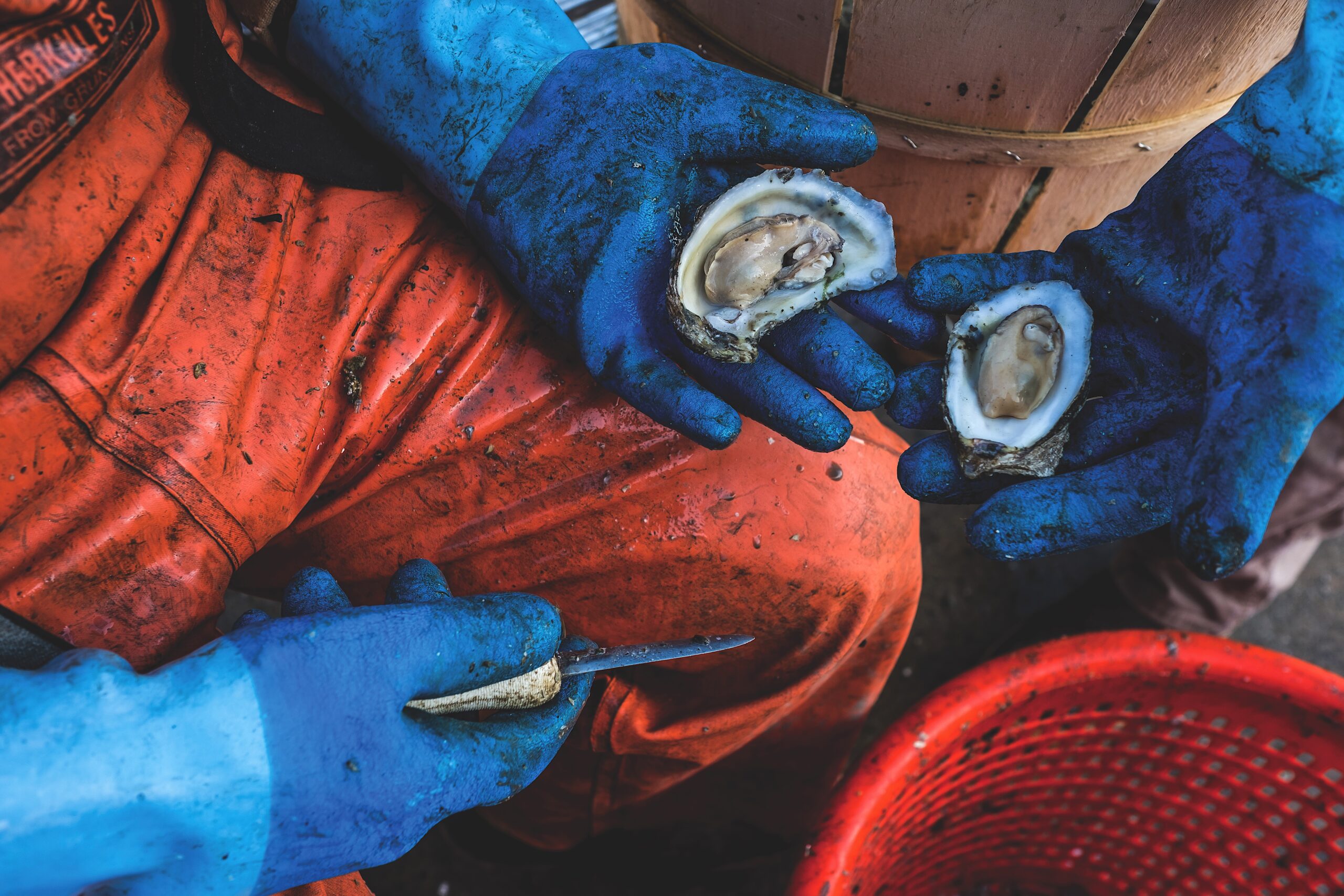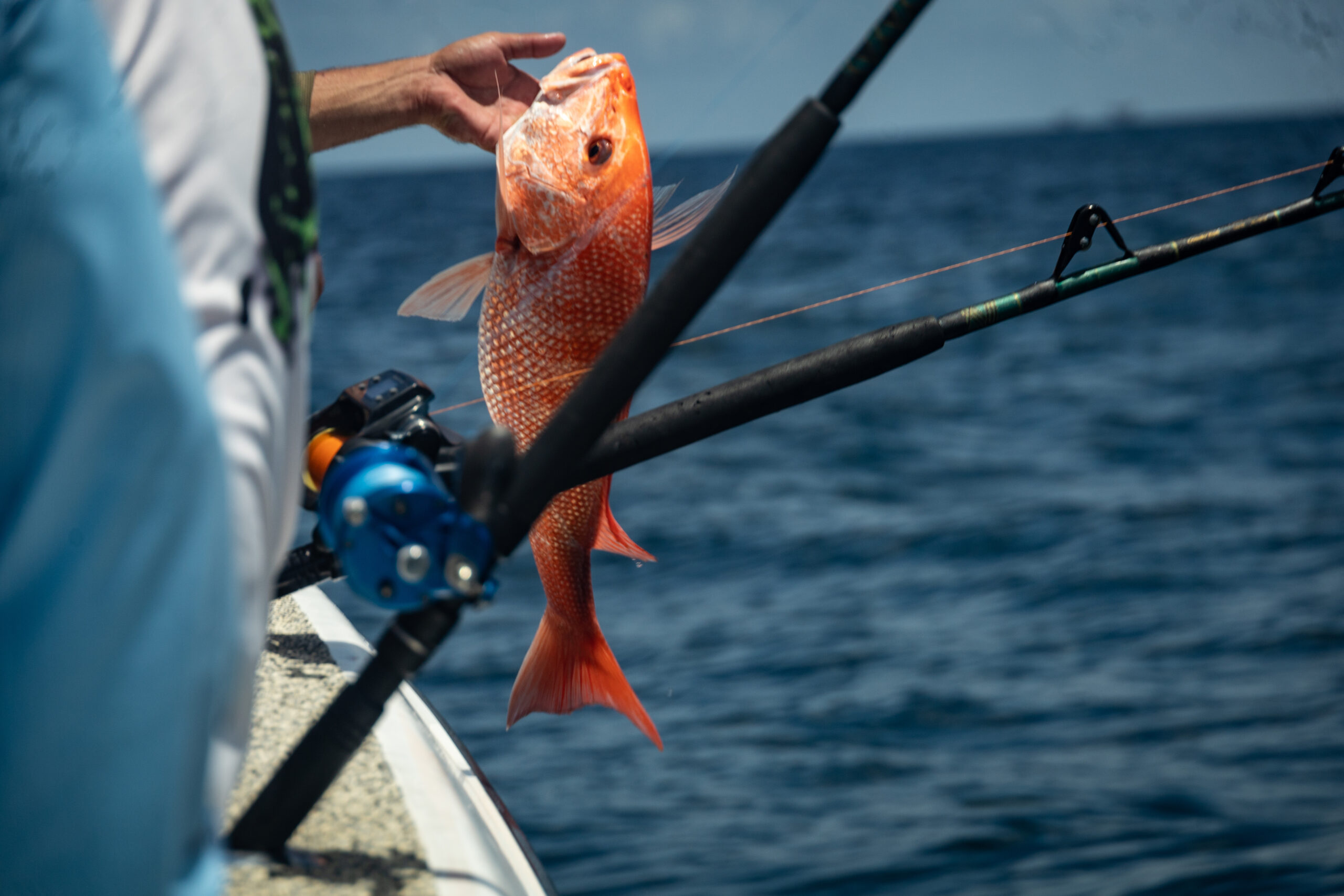Hook, Line & Science
Landing the Biggest Dolphinfish, Finding Black Sea Bass, Predicting Tournament Winners, and More
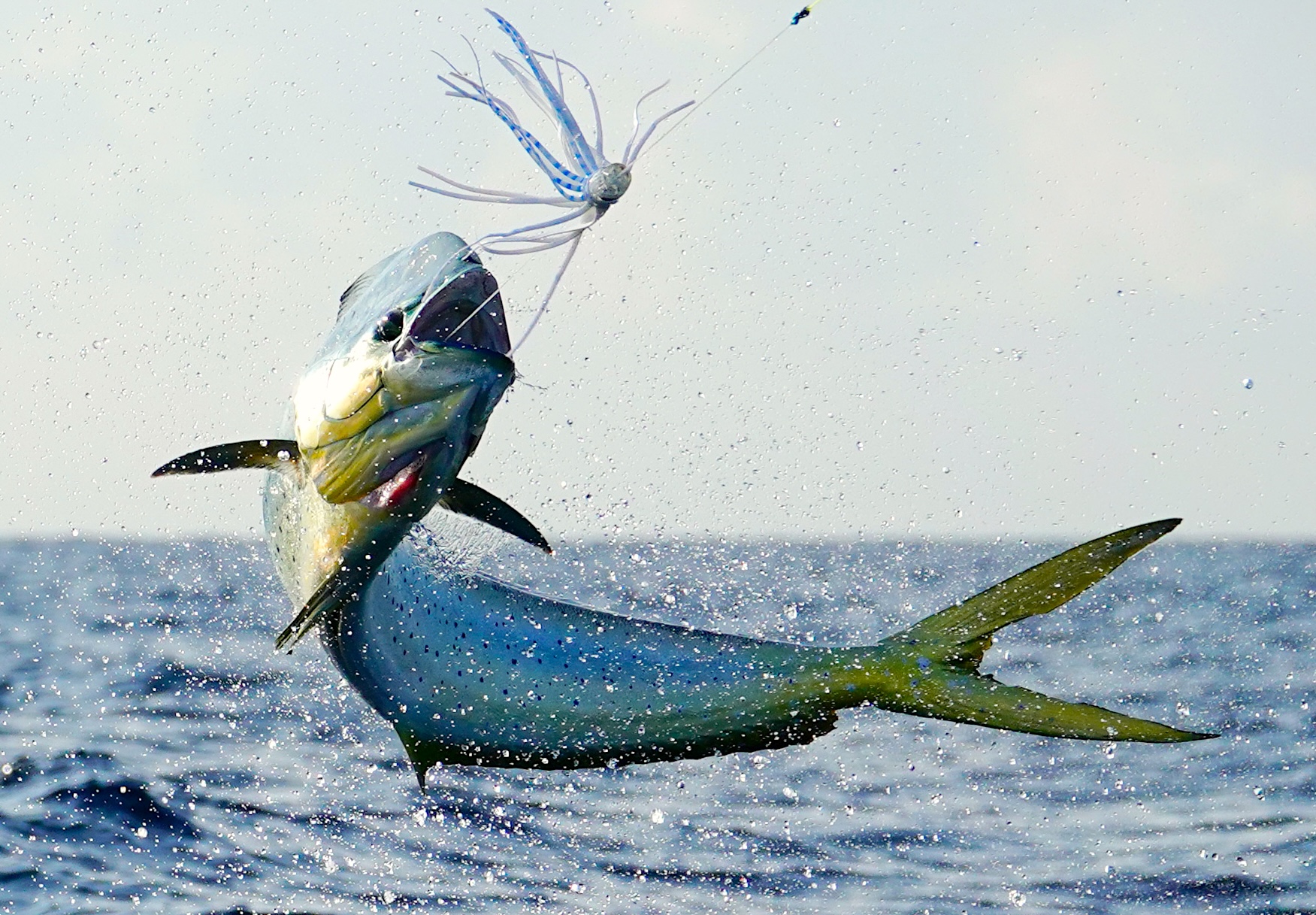
Are big dolphinfish getting harder to catch?
Two decades of fishing data raise concerns about this offshore favorite.
Dolphinfish, also known as mahi-mahi, are a prized catch among recreational anglers looking to reel in exceptionally large, trophy-sized fish.
However, a recent study revealed a steady decline in the size of dolphinfish at two major North Carolina fishing tournaments — the Big Rock Blue Marlin Tournament and the Hatteras Village Offshore Open. At Big Rock, the average length of male dolphinfish decreased by 6.6 inches from 2003 to 2023, while female lengths dropped by nearly 14 inches. The Hatteras tournament showed similar trends, with smaller but still significant declines.
But does catching smaller fish mean there are fewer large fish available?
The answer may lie in the number of angler trips it takes to catch an exceptionally large dolphinfish.
What did they study?
Researchers from NC State University, The Nature Conservancy, and the NC Department of Environmental Quality analyzed recreational fishing data from North Carolina gathered between 2000 and 2023. They used records of dolphinfish (weighing 35 pounds or more) from the North Carolina Saltwater Fishing Tournament, also known as the Citation Program. They combined this citation data with annual estimates of offshore recreational fishing trips from a federal survey program.
By dividing the number of angler trips by the number of dolphinfish citations, researchers calculated how much effort it took to catch one large dolphinfish. To help account for other factors that might affect citation rates or angler behavior — such as the popularity of the Citation Program or changing availability of official weigh stations — they ran the same analysis for wahoo, an offshore species that cohabitates with dolphinfish and that anglers commonly catch on the same trips.
What did they find?
The Citation Program awarded 4,619 dolphinfish citations from 2000 to 2023, with a high of 459 in 2001 and a low of 53 in 2023.
The number of trips required to catch a dolphinfish weighing at least 35 lbs. nearly quadrupled from 2000 to 2023. In 2000, landing a citation-sized dolphinfish took, on average, 1,853 angler trips, but by 2023, that number had risen to 9,701 trips.
In contrast, the research team found no trend for wahoo, suggesting that a decline in the number of large dolphinfish — rather than other factors — is why it takes more trips on average to catch one.
Anything else?
The timing of dolphinfish citation catches shifted less than four days over the 24-year study period. This small change suggests that migration patterns have not significantly changed and are unlikely to explain the declining numbers of large dolphinfish.
Incidentally, researchers found nearly identical results for dolphinfish and wahoo citation catches from for-hire trips.
Why It Matters
The sharp rise in effort needed to catch large dolphinfish, combined with other research showing declines in both commercial and recreational catches in the region, indicate the declining health of this stock. Because larger individuals produce more offspring, they play a crucial role in sustaining the species. Targeting these large, reproductive fish can hinder the stock’s ability to recover, raising concern about the health of the dolphinfish population.
These findings offer timely insight for fishery managers as they consider new conservation measures like size and bag limits.
the full study
Runde, B. J., Rudershausen, P. J., & Stilson, G. R. (2025). Evidence for declining numbers of large Dolphinfish in the western North Atlantic. North American Journal of Fisheries Management, 45(1), 169–175.
BY MADELINE PAYNE, communication fellow for Hook, Line & Science
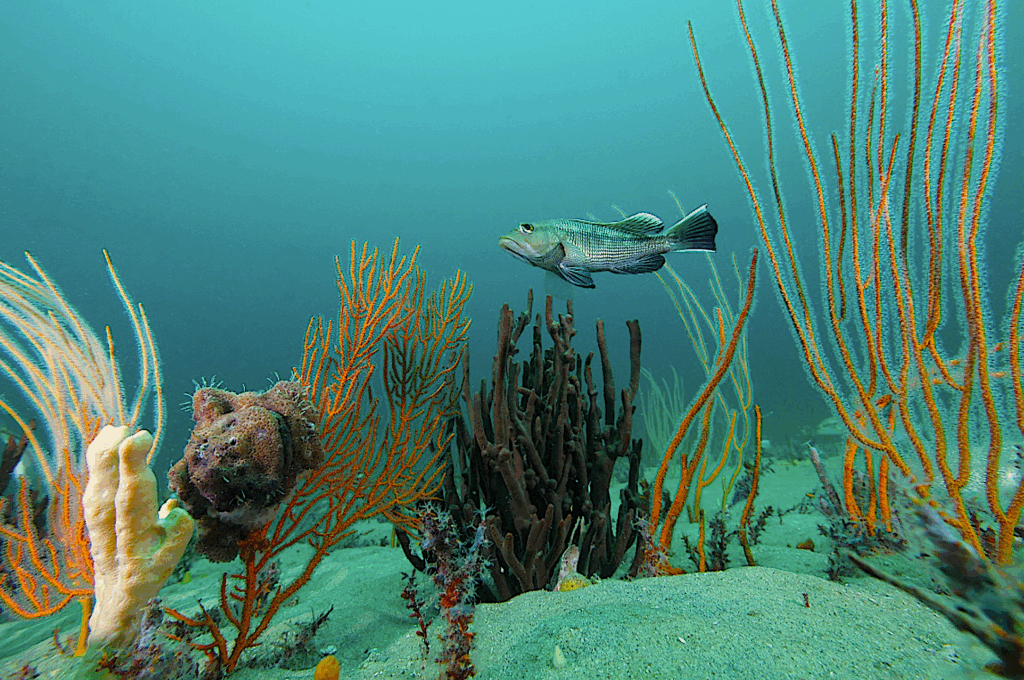
Where are all the black sea bass?
Maybe they’re migrating — but maybe not.
Human and environmental pressures shape the ecosystems of the Southeast U.S., impacting many reef fish species, including black sea bass. In response to environmental changes, fish may move to new areas to find suitable habitat, decline in number if their habitat is lost, or increase if more habitat becomes available.
Black sea bass populations illustrate all three responses. The migratory northern stock has expanded its range into the Gulf of Maine and increased in number, while the southern stock has declined in abundance. Although numbers improved following strict management regulations in 2010, the population began declining again in 2013, suggesting that other factors, such as the environment, may be at play.
As coastal environments continue to change, it’s important for managers to predict accurately how fish will respond. But the power of prediction relies on a data-driven understanding of individual fish species. Where do the fish live now? How many are there? How do they grow and reproduce?
What did they study?
NOAA-funded researchers from South Carolina Department of Natural Resources analyzed over 20 years of data from two long-term monitoring surveys off the Southeast coast. A trawl survey sampled small fish (1.5 to 6 inches) recently hatched in shallow waters, while a trap survey near reefs in deeper waters sampled fish that were about two years older.
From 2003 to 2022, the researchers compared the number of young fish caught in trawls with the number of slightly older fish later caught in traps to determine if juvenile fish numbers can predict the number of adult fish. Additionally, they looked at whether water temperature played a role in black sea bass abundance and distribution.
What did they find?
Between 2003 and 2022, trawl surveys caught 1,109 young black sea bass, while trap surveys caught over 40,000 adults. Juvenile fish numbers did not predict future adult numbers, possibly because trawls sample soft-bottom areas, which are not ideal for this reef-loving species.
The number of fish caught in traps indicated the adult population rose by 150% between 2003 and 2009, then dropped to record lows after 2016.
What else did they find?
Bottom water temperatures in the region rose from about 73℉ to 75℉, with recent years more than 3.5℉ warmer than the coldest years on record. Cooler years were often followed by stronger survival rates for young black sea bass, with more juveniles growing into adulthood. In contrast, recent warmer years have been linked to a decline in juvenile numbers.
Additionally, years that included higher adult black sea bass populations also found them concentrated farther south, while years with fewer adults saw a shift toward the northern part of their range.
Why It Matters
Warming could push the southern black sea bass stock farther north, leading to fewer fish in the south. However, it’s unclear whether this means the southern stock is shrinking or moving into areas once occupied by the northern stock. While trap surveys have done a good job tracking adult fish, trawl surveys may not fully capture the numbers of juveniles, highlighting the need for new sampling methods to better estimate the juvenile black sea bass population.
the full study
Vecchio, J. L., Finch, M. W., Spanik, K. R., Zimney, A., & Smart, T. I. (2025). Black Sea Bass Centropristis striata Year Class Strength and Spatial Extent from Two Long-Term Surveys off the Southeast U.S. Atlantic Coast. Fishes, 10(2), Article 2.
BY MADELINE PAYNE, communication fellow for Hook, Line & Science

Can we predict who wins a bass tournament?
Home field advantage may help determine the outcome.
Bass fishing is a popular sport in North Carolina and across the U.S., and tournaments are one way for professional anglers to compete against each other for cash, prizes, and bragging rights.
The concept of “home field advantage” — a significantly higher percentage of home team wins due to a wide range of benefits — plays a pivotal role in team sports, such as baseball, football, and basketball. However, in individual sports like tennis and golf, home field advantage plays a smaller role. And the role of home field advantage looks very ambiguous when we consider sports that incorporate both individual and team elements and how an individual participant’s score, for instance, contributes to an overall team score.
Professional bass fishing commentators often refer to local anglers’ advantages during televised events, such as previous experience with a particular tournament’s body of water. Fantasy fishing players often tend to select local anglers for their teams because of this perceived advantage.
But is this common notion a real home field advantage?
What did they study?
Researchers at the University of Arkansas examined two professional fishing league tournaments: the B.A.S.S. Bassmaster Elite Series (including 104 anglers) and the Major League Fishing Bass Pro Tour (including 66 anglers). The study spanned 18 total events.
The leagues share similarities in that both involve various locations essentially without spectators. Both leagues also involve a series of smaller tournaments in which fishers must “earn” their way into the finals.
The researchers focused on both the distance of an angler’s residence to the tournament and whether the tournament was located in an angler’s home state. They then compared these factors to tournament performance by looking at bag weight — the total weight of the fish an angler was allowed to keep,
What did they find?
The distance of an angler’s home to a tournament had a small effect on bag weight, with anglers who lived closer to the lake having higher bag weights.
Only in Texas did the home state correlate with a heavier bag. In the other states, this did not make a difference.
What else did they find?
Not surprisingly, greater age and career winnings also significantly increased bag weight. This suggests that practice and experience promote success in professional bass fishing, as is the case, of course, in many other sports.
Why It Matters
Understanding home field advantage could help fishing tournaments provide more even ground for opponents. Understanding home field advantage also could help fans better predict tournament outcomes, which might enhance other recreational activities — like fantasy sports and sports betting.
the full study
Settlage, Daniel M., and Settlage, Madison E. “Using orthodromic distance to determine homefield advantage in professional bass fishing tournaments.” Journal of Sports Economics, vol. 25, no. 7, 6 Aug. 2024, pp. 844–865.
BY RUTHIE FRONING, contributing editor for Coastwatch
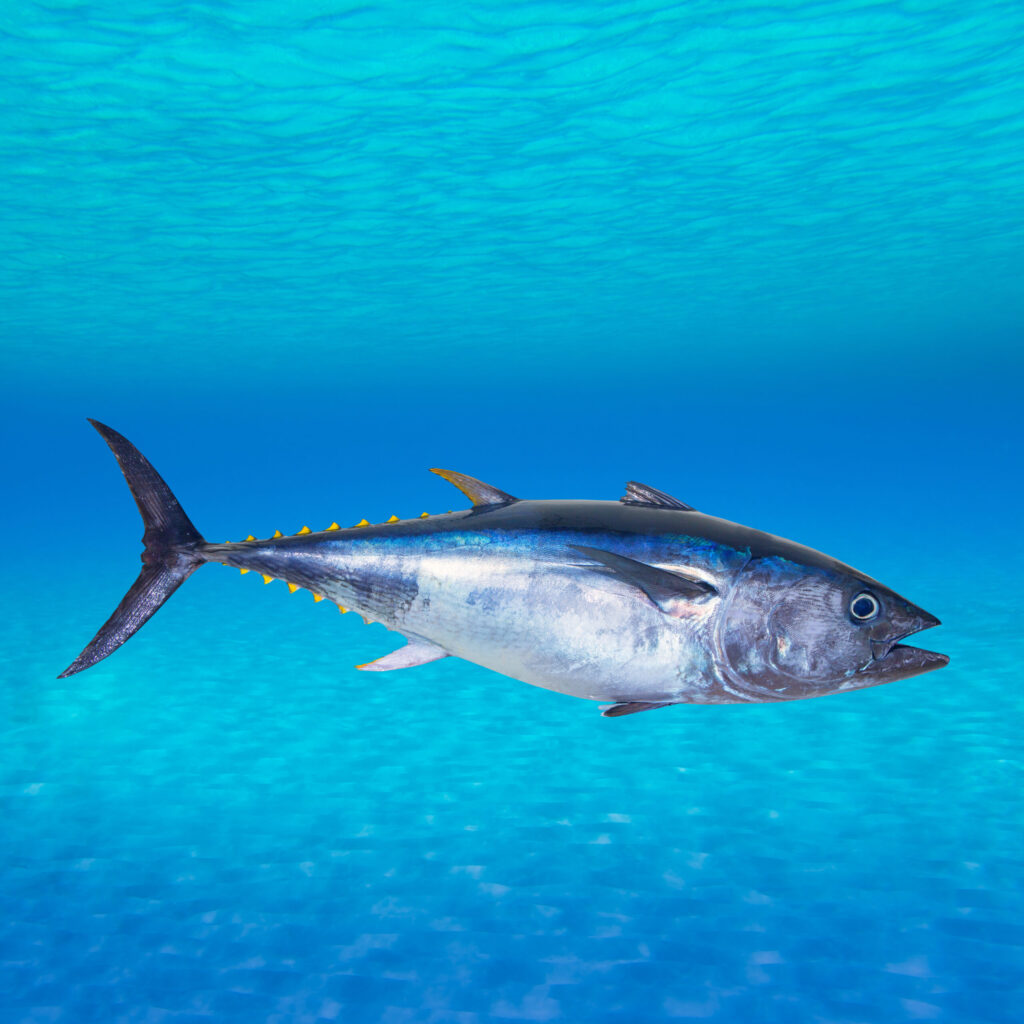
Did you report that bluefin tuna you posted on Facebook?
Almost all anglers agree that self-reporting is important to the bluefin’s long-term sustainability, but…
Angler self-reporting is a potentially efficient way to collect information about catches and dead discards in local fisheries. This, however, requires participation, which is not always straightforward. Both voluntary and mandatory self-reporting programs struggle with angler participation, and the reasons for this are not explicitly clear.
The recreational bluefin tuna fishery is popular along the East Coast from Maine to North Carolina. Social media posts are flooded with anglers proudly showcasing their catch of this species. Anglers are required to self-report their catch in this iconic fishery, but should we take it for granted that they always do?
What did they study?
Researchers from the American Saltwater Guides Association, Pelagic Strategies, William & Mary, and The Nature Conservancy examined the reasons for non-compliance among Massachusetts anglers in the bluefin tuna fishery, where self-reporting is mandatory.
Massachusetts anglers with a Highly Migratory Species (HMS) permit received a survey about past reporting compliance, opinions on self-reporting and fisheries management in general, and potential strategies to increase reporting compliance. The team then compared survey results between the anglers who had reported bluefin tuna and those that had not.
What did they find?
Based on the results, the team found that Massachusetts anglers reported about 42% of bluefin tuna catch. Greater than three-quarters (81.3%) of survey participants were non-reporters. Of the non-reporting anglers, 58.1% answered that they had caught a Bluefin Tuna within the past five years.
Opinion results varied, with a significant portion of reporters disagreeing that the fishery was managed effectively. A significant portion of non-reporters indicated that they were not aware of the self-reporting requirement.
Interestingly, almost all participants agreed that self-reporting is important to the fishery’s long-term sustainability.
What else did they find?
Angler opinions about potential strategies to increase reporting compliance were mixed.
For example, 80% of participants agreed that increasing the user-friendliness of the website would be effective. Reporters and non-reporters disagreed on the effectiveness of increased non-reporter penalties; less than 20% of reporters suggested tougher penalties, and 40% of non-reporters suggested increased penalties would not be effective.
Incentive strategies were the most popular idea for increasing compliance. Reminder strategies such as emails and signs were viewed as moderately effective, and strategies that placed an extra burden on anglers were least popular.
Why It Matters
Even though most anglers indicated that they are aware of the self-reporting requirement, compliance remains low. The survey indicates that employing strategies such as incentives and reminders may encourage anglers to self-report more frequently.
Furthermore, although this study was conducted for the bluefin tuna fishery in Massachusetts, its design and results can be applied to other fisheries with poor self-reporting rates.
Although all recreational anglers are required to hold NOAA HMS permits, North Carolina anglers are required to self-report with a different system. The compliance rate is unknown, but this research is also relevant for employing strategies to increase compliance rates across the country.
the full study
William M. Goldsmith, Andrew M. Scheld, Christopher McGuire, and Carl Lobue. 2023. Improving electronic reporting rates in the U.S. recreational fishery for Atlantic Bluefin Tuna. North American Journal of Fisheries Management.
BY RUTHIE FRONING, contributing editor for Coastwatch
Read more at HookLineScience.com
